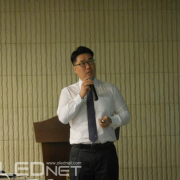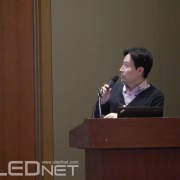Heraeus Materials Reveals Innovative Conductive Polymer Transparent Electrode

Heraeus Materials Korea’s Jinwhan Kim
By Choong Hoon Yi
At 2016 Production/Process Technology Development and Application Cases by Flexible Transparent Electrode and Film Materials Seminar (December 17), Heraeus Materials Korea’s Jinwhan Kim revealed new product of Clevios, Heraeus’ main transparent electrode series, through a presentation titled Conductive Polymer-based Flexible Transparent Electrode Production and Process Technology Development Trend and Application Examples.
Transparent electrode possesses high transmittance of ≥ 80% and conductivity of ≤ 500 Ω/ㅁ, and is being used as electronic component for displays including OLED electrode. The transparent electrode can be mainly categorized into 3 types: thin metal film, carbon allotrope, and conductive polymer. Heraeus Materials is considered a major company producing conductive polymer together with SKC.
Although many people regard Heraeus as a company producing gold and silver bullion, Kim explained that Heraeus is focusing on display and semiconductor related chemicals. Particularly, Kim added that Clevios, Heraeus’ representative product, contains over 20 years of PEDOT materials know-how and experience.
Clevios™ P, the existing PEDOT:PSS product, is mostly produced in Leverkusen, Germany, and essentially uses thermal curing. Kim revealed that when Clevios™ P is coated, it shows bluish hue and the degree changes depending on the thickness. The conductivity is 1,000 S/cm and has the refractive index similar to glass.
While the existing Clevios product has sufficient flexibility to be applied to flexible products, Kim reported that future flexible display requires transparent electrode with higher specifications, emphasizing the importance of product development, and introduced new product Clevios™ HY.
High conductive transparent electrode, Ag nanowire was added to the existing Clevios PEDOT:PSS product to produce Clevios™ HY. AG nanowire typically has rough surface but Clevios PEDOT:PSS corrects this by making it flat. The highly flexible new product has relatively low sheet tension of less than 100 Ω/ㅁ. Kim emphasized that this new product can be turned to solvent base and used in printing process, revealing they are developing Clevios™ HYJET, a PEDOT:PSS transparent electrode for printing use.


